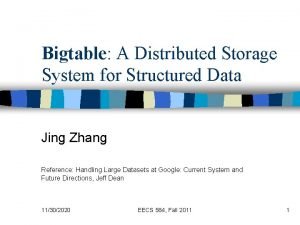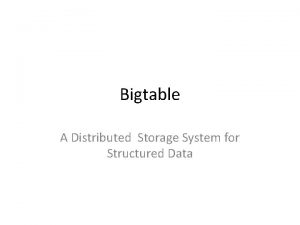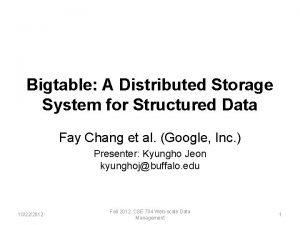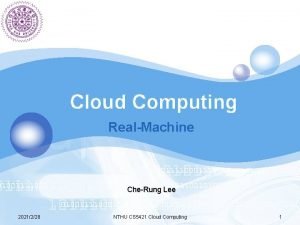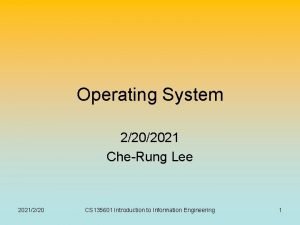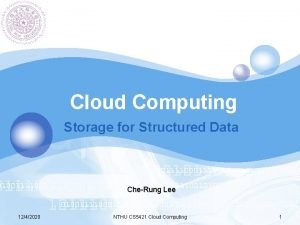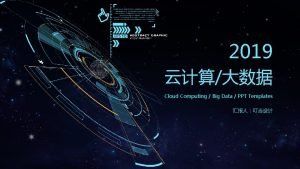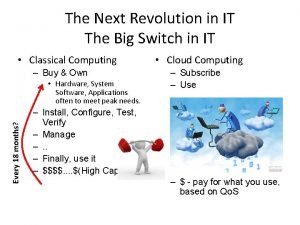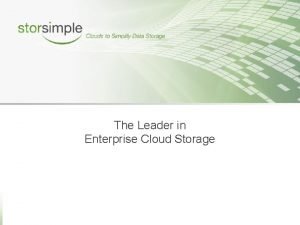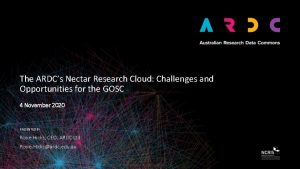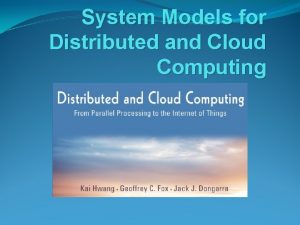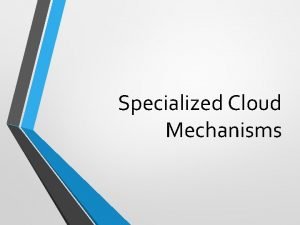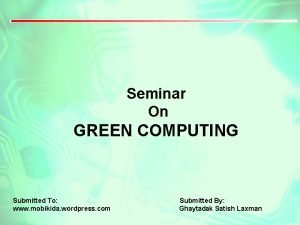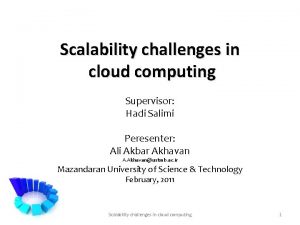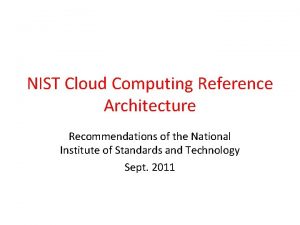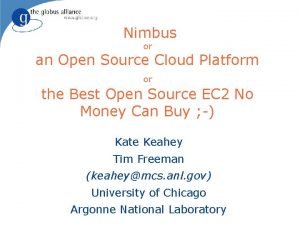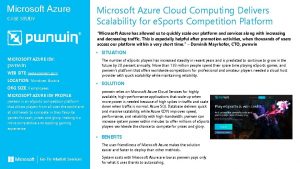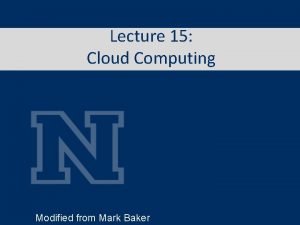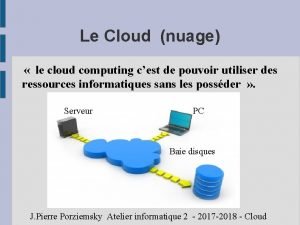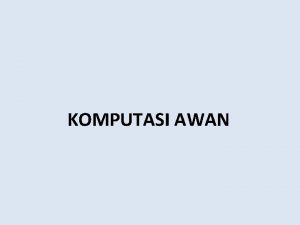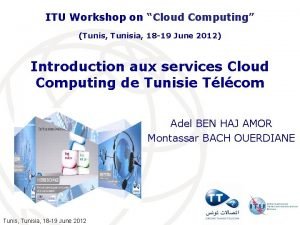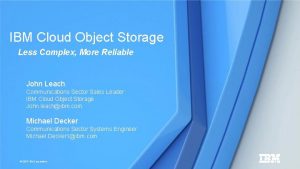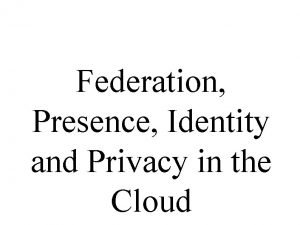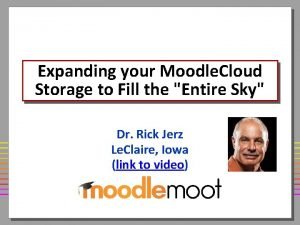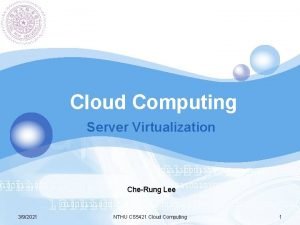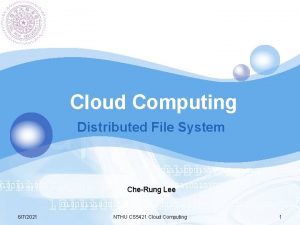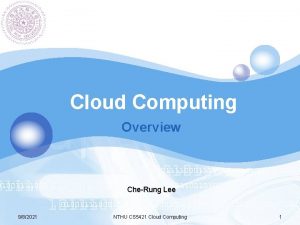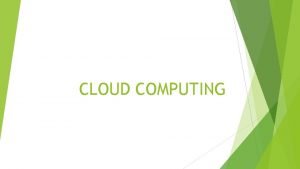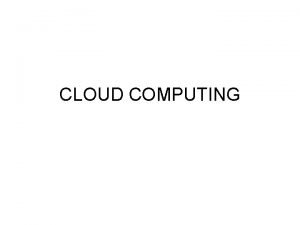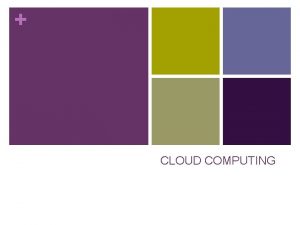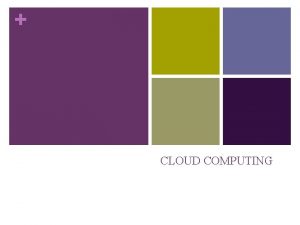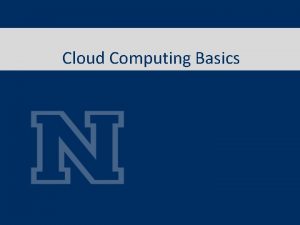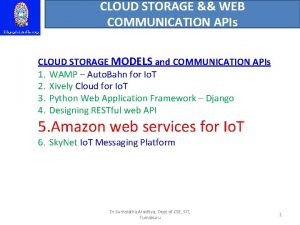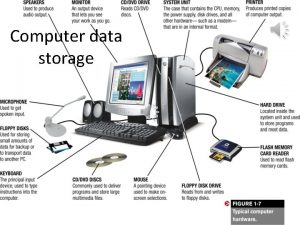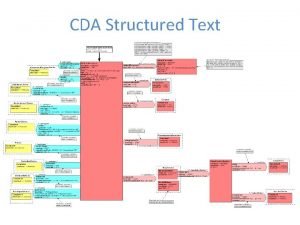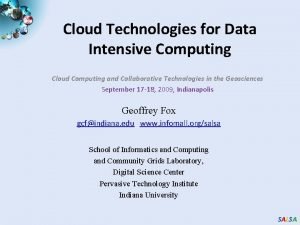LOGO Cloud Computing Storage for Structured Data CheRung













































- Slides: 45

LOGO Cloud Computing Storage for Structured Data Che-Rung Lee 12/4/2020 NTHU CS 5421 Cloud Computing 1

Outline v Database system § CAP theorem v NOSQL data storage § Google Big. Table § Hadoop HBase § Apache Cassendra 12/4/2020 NTHU CS 5421 Cloud Computing 2

Why File System Is Not Enough? 1. What we need is not only data, but also the relations among them. § The relations of data are also data § Also need data to describe data (metadata) 2. Common data operations are easier to perform using Data. Base Management System (DBMS) § § Search: retrieve data from the database Update: update existing data Insertion: insert new data Deletion: remove existing data

Relational Database v In a relational database (the most commonly used one), records are organized using tables § Columns for attributes; rows for records Name Student. ID Status Major Grade B-day Gender … 皮卡丘 123456 校 資 系 二年級 1 -1 -11 M … 可達鴨 789012 休 中文系 二年級 2 -2 -22 F … … … … v Primary key: one (or multiple) attributes that can be used to uniquely identify each row in a table

Query v Using SQL (Structured Query Language) Interested attributes v Ex: SELECT name, student. ID FROM student WHERE grade=2 AND gender=‘M’ v Ex: query all attributes Table name Condition SELECT * FROM student WHERE Student. ID=123456 v Indices for the attributes in conditions should be pre-built to speedup queries § Primary key is always indexed

Indexing v B-tree v Hash 12/4/2020 NTHU CS 5421 Cloud Computing 6

Relations v The relations among objects are described by the ER model (Entity-Relation model) Student Name, Student. ID, Status, … Course n take m Year, n Course. ID, Course. Name Schedule, … Teacher teac h 1 Name, Department, Teacher. ID, … v Relations are also organized as tables Course. Taking Course. Teaching Student. ID Course. ID Grade Status Teacher. ID Course. ID 123456 990110 -1 Normal 888999 990110 234567 990221 -1 Dropped 777666 990221 § What should be the primary key?

Joint Query v Select data from different tables through relations 科目名稱 上課時間 授課老師 英文 M 3 M 4 W 3 小瑤 微積分 T 3 T 4 H 3 H 4 小剛,小智 體育 F 5 F 6 小智 … … … SELECT Course. Name, Course. Schedule, Teacher. Name FROM Course, Course. Taking, Course. Teaching, Student, Teacher WHERE Student. ID=‘ 123456’ AND Usually will Student. ID=Course. Taking. Student. ID AND build a “view” Course. Taking. Course. ID=Course. ID AND to speedup Course. Teaching. Course. ID=Course. ID AND common Course. Teaching. Teacher. ID=Teacher. ID. queries 12/4/2020 NTHU CS 5421 Cloud Computing 8

Join Operation v Where x =123 and y = ‘abc’ v It’s a set join problem 12/4/2020 NTHU CS 5421 Cloud Computing 9

Update, Insertion, Deletion v Suppose you want to add a course for next semester. INSERT INTO Course. Taking VALUES (‘ 123456’, ’ 990110’); v A transaction is more than just an insertion like that. A sequence of operations must happen all together § Before insertion • The system needs to check if there is a schedule confliction • Also, the capacity of the class, the pre-requirement, … § After insertion • Suppose there is an attribute in Course, called “No. Student”, that records the total number of students taking this course. UPDATE Course SET No. Student=ns+1 WHERE Course. ID=‘ 990110’;

ACID Properties of Transactions v Atomicity: either all the operations of a transaction are executed or none of them are. v Consistency: the database is in a legal state before and after a transaction v Isolation: the effects of one transaction are isolated from other transactions. v Durability the effects of successfully completed transactions endure subsequent failures. 12/4/2020 NTHU CS 5421 Cloud Computing 11

Database Integrity v DBMS need to maintain database integrity § Transaction log: non-volatile record of each transaction’s activities, built before the transaction is allowed to happen. § Locking: preventing others from accessing data being used by a transaction. § Roll-back: procedure to undo a failed, partially completed transaction.

Distributed RDBMS v Distributed database management systems is a software for managing databases stored on multiple computers in a network. v A natural way to scale up the DBMS 12/4/2020 NTHU CS 5421 Cloud Computing 13

Consistency Problem v Ex: A writes v 1 to DB and B reads the data 12/4/2020 NTHU CS 5421 Cloud Computing 14

Brewer's CAP Theorem v It is impossible for a distributed computer system to provide all three of § Consistency: all nodes see the same data at the same time § Availability: a guarantee that every request receives a response about whether it was successful or failed § Partition tolerance: the system continues to operate despite arbitrary message loss 12/4/2020 NTHU CS 5421 Cloud Computing 15

Outline v Database system § CAP theorem v NOSQL data storage § Google Big. Table § Hadoop HBase § Apache Cassendra 12/4/2020 NTHU CS 5421 Cloud Computing 16

Problems of RDBMS v Modern RDBMS have shown poor performance on certain data-intensive applications, § Indexing a large number of documents, § Serving pages on high-traffic websites, § Delivering streaming media. 12/4/2020 NTHU CS 5421 Cloud Computing 17

Example of Webpage DB v How to build tables for webpages for queries like v Schema 1: § § Table 1: webpage Table 2: terms Table 3: contains Join is slow v Schema 2: § Sparse 12/4/2020 Webpage URL Terms n URL, clou d 雲 www. nthu. edu. tw www. google. com 1 NTHU CS 5421 Cloud Computing con tain s 端 m Words from dictionary 學 清 華 2 2 2 18

NOSQL v Not Only SQL § Carlo Strozzi used the term No. SQL in 1998 § Eric Evans, a Rackspace employee, reintroduced the term No. SQL in early 2009 v Properties § § May not require fixed table schemas, Usually avoid join operations, Typically scale horizontally, Relax the data consistency requirement. 12/4/2020 NTHU CS 5421 Cloud Computing 19

Column Oriented Layout v DBMS stores rows contiguously on disk v Column oriented layout is very effective to store very sparse data as well as multi-value cell. v Each “table” stores the key and value pair. v Each column can be stored in one file. 12/4/2020 NTHU CS 5421 Cloud Computing 20

Google Big. Table v The basic data storage unit is a cell, § Addressed by a particular row and column § Multiple timestamp version of data within a cell. v Bigtable allows users to specify how many versions can be stored within each cell § By count (how many) or by freshness (how old). 12/4/2020 NTHU CS 5421 Cloud Computing 21

Sequential Write v Big. Table is highly optimized for write operation with sequential write (no disk seek is needed). § Appending a transaction entry to a log file (the disk write is sequential with no disk seek), § Write the data into an in-memory Memtable. § In case of the machine crashes and all in-memory state is lost, the recovery step will bring the Memtable up to date by replaying the updates in the log file. 12/4/2020 NTHU CS 5421 Cloud Computing 22

SSTable v All the latest update therefore will be stored at the Memtable, which will grow until reaching a size threshold, then it will flushed the Memtable to the disk as an SSTable. Over a period of time there will be multiple SSTables on the disk that store the data. 12/4/2020 NTHU CS 5421 Cloud Computing 23

Merged Read v ”Merged Read" means multiple places to lookup data when a read request is arrived. § It first looks at the Memtable by the row key of request. If not, it will look at the on-disk SSTables. v It is inefficient for read when there are too many SSTables scattering around. § To speed up the detection, SSTable has a companion Bloom filter such that it can rapidly detect the absence of the row-key. § The system periodically merge the SSTables. 12/4/2020 NTHU CS 5421 Cloud Computing 24

Bloom Filter v Conceived by Burton Howard Bloom in 1970 v A probabilistic data structure that is used to test whether an element is a member of a set. § False positives are possible, but not false negatives. v Ex: a set={x, y, x}, query=w § Elements are hashed to different bits § One of the hashed bit of w is 0, so it is not in the set. 12/4/2020 NTHU CS 5421 Cloud Computing 25

Periodic Data Compaction v To merge the SSTables periodically. v Each SSTable is individually sorted by key, § A simple "merge sort" is sufficient to merge multiple SSTable into one. v Two SSTable of the same size will be merge into a single SSTable first, which doubles the size. § The number of SSTable is proportion to O(log. N) where N is the number of rows. 12/4/2020 NTHU CS 5421 Cloud Computing 26

Big. Table Operation Summary Full Frozen memtable V 5. 0 A new memtable Tablet log Read ops V 4. 0 Write ops Minor compaction Memtable -> a new SSTable V 3. 0 V 2. 0 SSTable files V 6. 0 V 1. 0 Merging Major compaction Memtable + a+ few all SSTables -> ->Atonew one. SSTable Periodically Deleted data done. are Deleted removed data are still Storage can alive. be re-used

Tablets in Big. Table v Large tables broken into tablets at row boundaries § Tablet holds contiguous range of rows • Clients can often choose row keys to achieve locality § Aim for ~100 MB to 200 MB of data per tablet v Serving machine responsible for ~100 tablets § Fast recovery: • 100 machines each pick up 1 tablet from failed machine § Fine-grained load balancing: • Migrate tablets away from overloaded machine • Master makes load-balancing decisions

Dynamic Fragmentation of Rows v Tablets split and merge § automatically based on size and load § or manually v Load balancing v Clients can choose row keys to achieve locality Tablet 64 K block Start: aardvark 64 K block End: apple SSTable Index 64 K block SSTable Index

Tablet Assignment Cluster manager 1) Start a server Master keeps track of the set of live tablet servers, and the current assignment of tablets to tablet servers, including which tablets are unassigned Chubby Tablet servers 8) Reassign 7) Acquire and unassigned Delete the lock tablets 2) Create a lock 3) Acquire the lock 4) Monitor Tablet Server 5) Assign tablets 6) Check lock status Master Server

Tablet Serving Memory read memtable (random-access) append-only log on GFS write SSTable on GFS Tablet SSTable: Immutable on-disk ordered map from string->string keys: <row, column, timestamp> triples

Locating Tablets MD 0

Chubby v Central service for distributed coordination § Store coordination information § Helps synchronization § Master election: many servers try to get the same lock, the one who gets it is the master § Used by many Google technologies like GFS and Big. Table 12/4/2020 NTHU CS 5421 Cloud Computing 33

Locating Tablets v Approach: 3 -level B+-tree like scheme for tablets § 1 st level: Chubby, points to MD 0 (root) § 2 nd level: MD 0 data points to appropriate METADATA tablet § 3 rd level: METADATA tablets point to data tablets v METADATA tablets can be split when necessary v MD 0 never splits so number of levels is fixed

Differences from RDBMS v Transaction protection is only guaranteed within a single row, not multiple rows v Inconsistency § While you are reading a row, other people may have modified the same row and update it before you. Your view is not current anymore but your later update can easily wipe off other people's change. § For the application Google interested, it’s few concurrent row updates. v Lack of surrounding tools 12/4/2020 NTHU CS 5421 Cloud Computing 35

Differences from RDBMS (cont’) v No indexes § There is no index from the column value to its containing rowid. § If users require index in Bigtable, they need to build their own index at the application level. v No referential integrity enforcement § If users build artificial index at the application level, they need to maintain the integrity of index when the base data is inserted, modified or deleted. 12/4/2020 NTHU CS 5421 Cloud Computing 36

HBase v Based on the Big. Table, HBase uses the Hadoop Filesystem (HDFS) as its data storage engine. v HBase doesn't need to worry about data replication, data consistency and resiliency because HDFS has handled it already. § It is also constrained by the characteristics of HDFS, which is not optimized for random read access. § There will be an extra network latency between the DB server to the File server (which is the data node of Hadoop). 12/4/2020 NTHU CS 5421 Cloud Computing 37

HBase Architecture

How Does HBase Work?

Big. Table v. s. HBase Big. Table Master Tablet server Google file system SSTable Chubby Memtable 12/4/2020 HBase Master Region server HDFS HFile Zookeeper Memcached NTHU CS 5421 Cloud Computing 40

Key-to-Server Mapping v Master server v Root region server v Meta region server v User region server v Region server v Memcached 12/4/2020 NTHU CS 5421 Cloud Computing 41

Differences from Bigtable v Number of Master § Hbase added support for multiple masters. These are on "hot" standby and monitor the master's Zoo. Keeper node v Storage System § Hbase has the option to use any file system as long as there is a proxy or driver class for it • HDFS, S 3(Simple Storage Service), S 3 N(S 3 Native File. System) v Memory Mapping § Big. Table can memory map storage files directly into memory

Differences from Bigtable (cont. ) v Lock Service § Zoo. Keeper is used to coordinate tasks in Hbase as opposed to provide locking services § Zoo. Keeper does for Hbase pretty much what Chubby does for Big. Table with slightly different semantics v Locality Groups § Hbase does not have this option and handles each column family separately

Cassandra v Based on the Big. Table model, Cassandra uses the distributed hash table to partition its data, § Based on the DHT in the Amazon Dynamo model. v Data is replicated across multiple servers. v Allows user to choose the consistency level that is suitable to application. 12/4/2020 NTHU CS 5421 Cloud Computing 44

References v Prof. Chung’s slides v Wikipedia and Internet v http: //www. julianbrowne. com/article/viewer/brew ers-cap-theorem v http: //horicky. blogspot. com/search? q=nosql 12/4/2020 NTHU CS 5421 Cloud Computing 45
 The cloud in cloud computing refers to
The cloud in cloud computing refers to Bigtable a distributed storage system for structured data
Bigtable a distributed storage system for structured data Bigtable: a distributed storage system for structured data
Bigtable: a distributed storage system for structured data Bigtable: a distributed storage system for structured data
Bigtable: a distributed storage system for structured data Cherung
Cherung Cherung
Cherung 2021220
2021220 Cherung
Cherung Cherung
Cherung Types of interviews structured semi structured unstructured
Types of interviews structured semi structured unstructured Sa/sd methodology
Sa/sd methodology Primary storage vs secondary storage
Primary storage vs secondary storage Big data in cloud computing ppt
Big data in cloud computing ppt Convert unstructured data to structured data
Convert unstructured data to structured data Secondary storage vs primary storage
Secondary storage vs primary storage Secondary storage provides temporary or volatile storage
Secondary storage provides temporary or volatile storage Object based and unified storage
Object based and unified storage Conventional computing and intelligent computing
Conventional computing and intelligent computing Vodafone business hosting services
Vodafone business hosting services Virtualization techniques in cloud computing
Virtualization techniques in cloud computing Tools and mechanisms for virtualization
Tools and mechanisms for virtualization Stratus clouds
Stratus clouds Cloud computing reference model
Cloud computing reference model Enterprise cloud storage
Enterprise cloud storage Ardcs
Ardcs Distributed system models in cloud computing
Distributed system models in cloud computing Specialized cloud mechanisms
Specialized cloud mechanisms Green computing seminar
Green computing seminar Paper cut uga
Paper cut uga Scalability issues in cloud computing
Scalability issues in cloud computing Conclusion cloud computing
Conclusion cloud computing Unified management software in cloud computing
Unified management software in cloud computing Nist architecture in cloud computing
Nist architecture in cloud computing Nimbus cloud computing
Nimbus cloud computing Cloud computing cambridge
Cloud computing cambridge Case study on microsoft azure in cloud computing
Case study on microsoft azure in cloud computing Cloud computing layers
Cloud computing layers Regarder introduction to cloud computing
Regarder introduction to cloud computing Stor simple
Stor simple Sejarah cloud computing
Sejarah cloud computing Kentico cloud
Kentico cloud Cloud computing tunisie
Cloud computing tunisie Critical capabilities for object storage
Critical capabilities for object storage Hpe nimble cloud volumes
Hpe nimble cloud volumes Presence in the cloud
Presence in the cloud Moodle cloud
Moodle cloud

